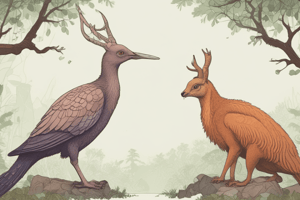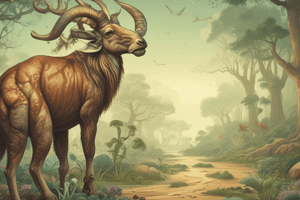Podcast
Questions and Answers
Which group is considered a monophyletic group (clade)?
Which group is considered a monophyletic group (clade)?
- Group IV
- Group III
- Group II
- Group I (correct)
Which group is considered a paraphyletic group?
Which group is considered a paraphyletic group?
- Group III
- Group II (correct)
- Group I
- Group IV
Which group is considered a polyphyletic group?
Which group is considered a polyphyletic group?
- Group II
- Group I
- Group IV
- Group III (correct)
What is the definition of a monophyletic group (clade)?
What is the definition of a monophyletic group (clade)?
What is the definition of a paraphyletic group?
What is the definition of a paraphyletic group?
What is the definition of a polyphyletic group?
What is the definition of a polyphyletic group?
Which group does not include all the descendants of the common ancestor?
Which group does not include all the descendants of the common ancestor?
Which group includes the most recent common ancestor of its members?
Which group includes the most recent common ancestor of its members?
Which group consists of species that share similar characteristics?
Which group consists of species that share similar characteristics?
Which group consists of an ancestral species and all of its descendants?
Which group consists of an ancestral species and all of its descendants?
Which of the following is an example of a shared ancestral character?
Which of the following is an example of a shared ancestral character?
Which of the following is an example of a shared derived character?
Which of the following is an example of a shared derived character?
What is the term for the group of species being studied?
What is the term for the group of species being studied?
What is the term for a species or group of species closely related to but not part of the ingroup?
What is the term for a species or group of species closely related to but not part of the ingroup?
Why is the group of even-toed ungulates considered polyphyletic?
Why is the group of even-toed ungulates considered polyphyletic?
What can help to infer evolutionary relationships?
What can help to infer evolutionary relationships?
Which of the following is an example of a shared derived character in the context of the entire animal kingdom?
Which of the following is an example of a shared derived character in the context of the entire animal kingdom?
Which of the following is an example of a shared ancestral character in the context of the group including mammals?
Which of the following is an example of a shared ancestral character in the context of the group including mammals?
What is the term for the evolutionary novelty unique to a particular clade?
What is the term for the evolutionary novelty unique to a particular clade?
What can branch lengths in a phylogenetic tree indicate?
What can branch lengths in a phylogenetic tree indicate?
Flashcards
Monophyletic group
Monophyletic group
A group that includes an ancestral species and all its descendants.
Paraphyletic group
Paraphyletic group
A group that doesn't include all descendants of the common ancestor.
Polyphyletic group
Polyphyletic group
A group with species that don't share a recent common ancestor.
Shared ancestral character
Shared ancestral character
Signup and view all the flashcards
Shared derived character
Shared derived character
Signup and view all the flashcards
Ingroup
Ingroup
Signup and view all the flashcards
Outgroup
Outgroup
Signup and view all the flashcards
Clade
Clade
Signup and view all the flashcards
Evolutionary change
Evolutionary change
Signup and view all the flashcards
Phylogenetic tree
Phylogenetic tree
Signup and view all the flashcards
Autapomorphy
Autapomorphy
Signup and view all the flashcards
Molecular data
Molecular data
Signup and view all the flashcards
Morphological data
Morphological data
Signup and view all the flashcards
Branch Length
Branch Length
Signup and view all the flashcards
Study Notes
Phylogenetic Groups
- A monophyletic group (clade) is a group that includes an ancestral species and all of its descendants.
- A paraphyletic group is a group that does not include all the descendants of the common ancestor.
- A polyphyletic group is a group that consists of species that share similar characteristics, but do not share a recent common ancestor.
Definitions
- A monophyletic group (clade) is a group that includes all descendants of a single common ancestor.
- A paraphyletic group is a group that excludes some, but not all, descendants of a single common ancestor.
- A polyphyletic group is a group that includes species that do not share a recent common ancestor, but are grouped together based on shared characteristics.
Characteristics of Phylogenetic Groups
- A monophyletic group includes the most recent common ancestor of its members.
- A paraphyletic group does not include all the descendants of the common ancestor.
- A polyphyletic group consists of species that share similar characteristics, but do not share a recent common ancestor.
Types of Characters
- A shared ancestral character is a characteristic present in an ancestral species and inherited by its descendants.
- A shared derived character is a characteristic that has evolved in a particular group of organisms and is present in all members of that group.
Terminology
- The group of species being studied is called the ingroup.
- A species or group of species closely related to but not part of the ingroup is called the outgroup.
Examples
- The group of even-toed ungulates is considered polyphyletic because it includes species that do not share a recent common ancestor, but are grouped together based on shared characteristics.
- Molecular or morphological data can help to infer evolutionary relationships.
- The presence of hair is an example of a shared derived character in the context of the entire animal kingdom.
- The presence of mammary glands is an example of a shared ancestral character in the context of the group including mammals.
- An autapomorphy is the term for an evolutionary novelty unique to a particular clade.
- Branch lengths in a phylogenetic tree can indicate the amount of evolutionary change that has occurred in a particular group.
Studying That Suits You
Use AI to generate personalized quizzes and flashcards to suit your learning preferences.




